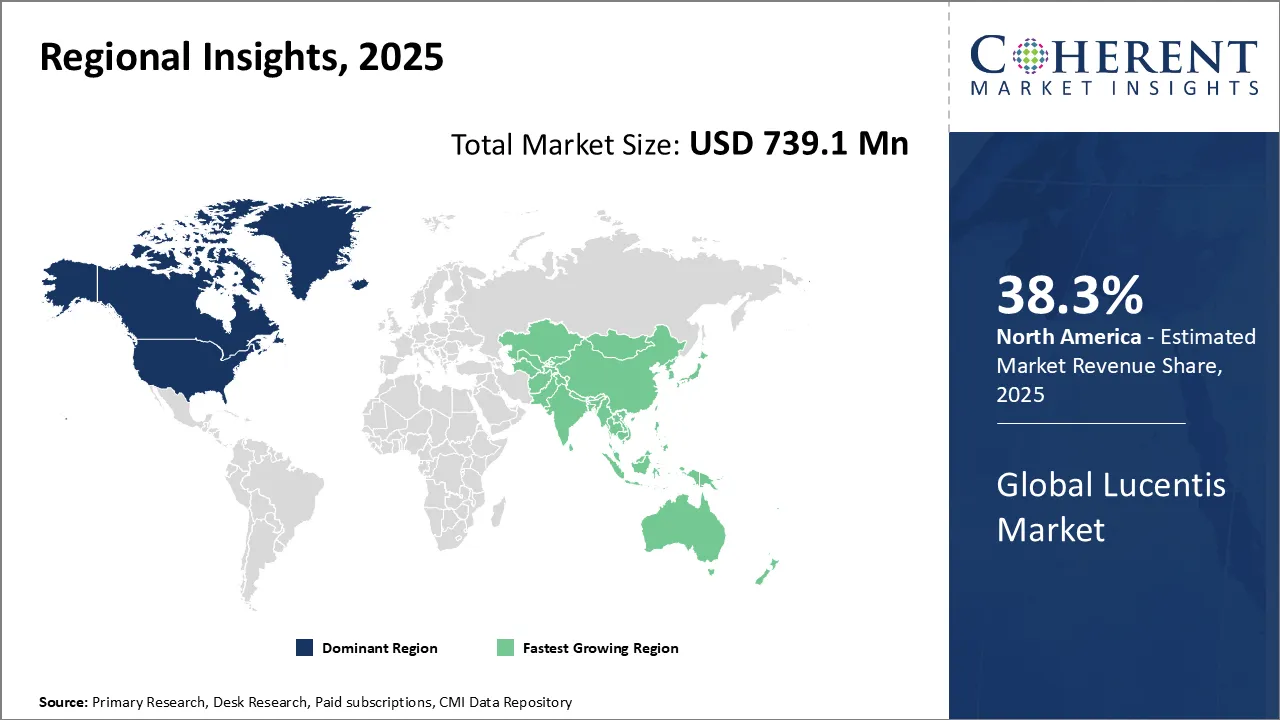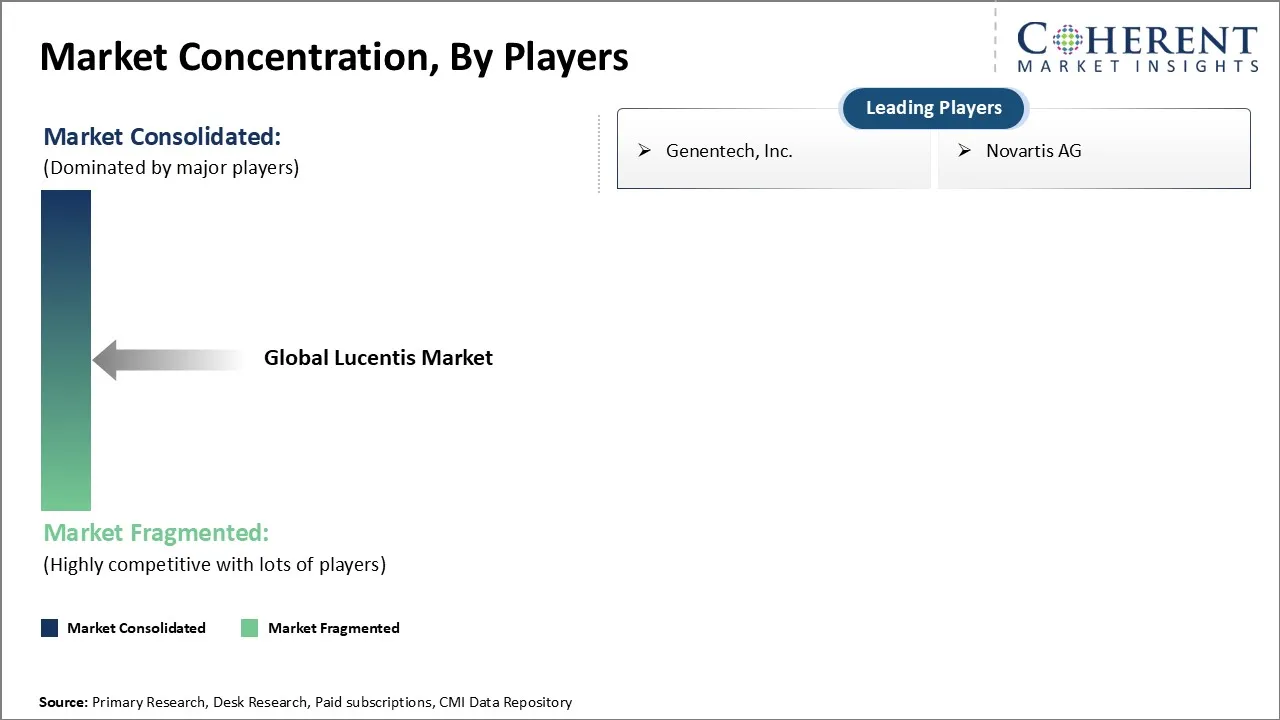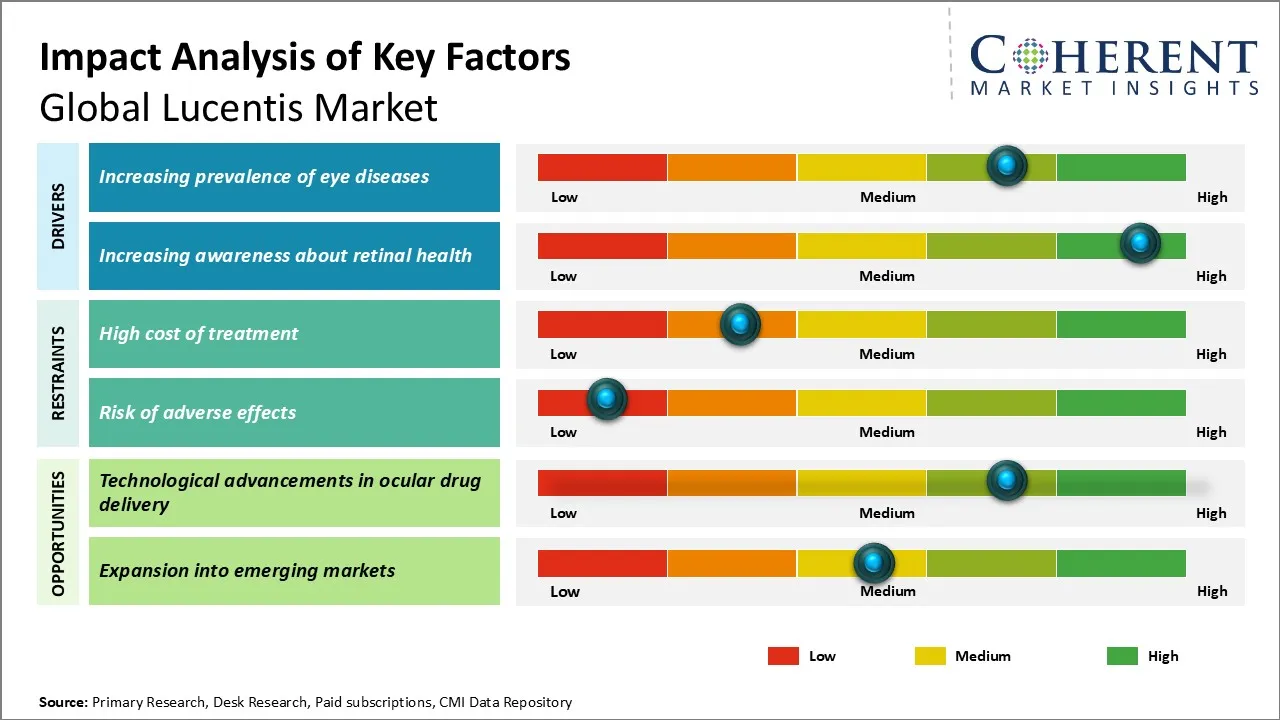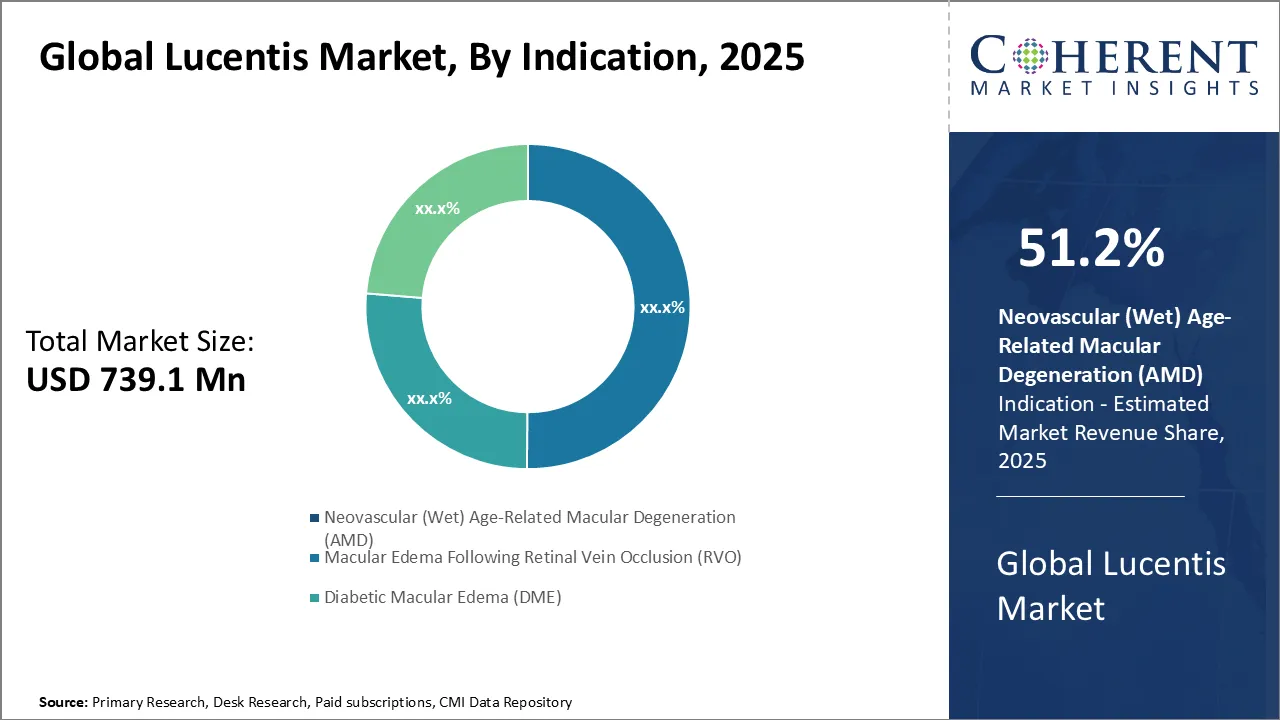Global Lucentis Market Size and Forecast
The Global Lucentis Market is estimated to be valued at USD 739.1 Mn in 2025 and is expected to reach USD 64.1 Mn by 2032, exhibiting a compound annual growth rate (CAGR) of -29.5% from 2025 to 2032. Despite the increasing prevalence of age-related macular degeneration (AMD), diabetic retinopathy, the market is experiencing a decline due to factors such as the emergence of alternative treatments, biosimilars, and cost-related challenges. These factors are limiting the expansion of the Lucentis market, even though awareness about the importance of early diagnosis and treatment continues to rise.
Key Takeaways of the Global Lucentis Market
- In 2025, Neovascular (Wet) Age-Related Macular Degeneration (AMD) segment is projected to hold the largest share of the global Lucentis market by indication, contributing 51. 2%.
- By dosage strength, the 0.5 mg/10 mg/mL solution segment leads the market with an estimated 55.2% share in 2025.
- Additionally, the pre-filled syringe segment dominates the packaging segment, accounting for approximately 64.3% of the total market share in 2025.
- North America is expected to lead the market, holding a share of 38.3% in 2025. Asia Pacific is anticipated to be the fastest-growing region, with a market share of 25.3% in 2025.
Market Overview
The market trend for Lucentis is characterized by the development of novel drug delivery systems, such as sustained-release formulations and implantable devices, which aim to improve patient compliance and treatment outcomes. Additionally, there is a growing focus on combination therapies that harness the synergistic effects of Lucentis with other medications to enhance its efficacy. Furthermore, the increasing adoption of telemedicine and remote monitoring solutions is expected to streamline patient care and facilitate early intervention in the management of retinal disorders.
Currents Events and their Impact
|
Current Events |
Description and its impact |
|
Increased Global Focus on Elderly Eye Care |
|
|
Emergence of Biosimilars in Market |
|
Uncover macros and micros vetted on 75+ parameters: Get instant access to report
Lucentis Market Insights, By Indication - Neovascular (wet) age-related macular degeneration (AMD) segment dominates due to Increasing prevalence of AMD in the aging global population
In terms of indication, Neovascular (Wet) Age-Related Macular Degeneration (AMD) segment is expected to account for the highest market share of 51.2% in 2025. Firstly, the increasing prevalence of AMD, particularly in the aging population, has significantly contributed to the demand for Lucentis as an effective treatment option. AMD is a progressive eye disorder that affects the central part of the retina, leading to vision loss and blindness if left untreated. The growing awareness about the importance of early diagnosis and treatment of AMD has further propelled the adoption of Lucentis in this segment.
According to research article by Academy of Managed Care Pharmacy, in January 2025, Wet age-related macular degeneration (AMD) affects about 1.2% to 1.3% of older adults enrolled in U.S. Medicare Advantage plans each year. It is most common in people aged 75 and above and those of White ethnicity. Around 1 in 4 people with geographic atrophy (GA) also have wet AMD, showing that many patients suffer from both advanced forms of the disease.
Moreover, Lucentis has demonstrated remarkable efficacy in treating Neovascular Wet AMD, with clinical trials showcasing its ability to improve and maintain visual acuity in patients. The drug's targeted mechanism of action, which involves inhibiting the growth of abnormal blood vessels in the retina, has made it a preferred choice among healthcare professionals.
Lucentis Market Insights, By Dosage Strength - 0.5 mg/10 mg/mL solution segment dominates due to extensive clinical validation supporting efficacy across multiple retinal disorders
In terms of dosage strength, the 0.5 mg/10 mg/mL solution segment is projected to hold the highest market share of 55.2% in 2025. This can be attributed to several factors that have made this dosage strength the preferred choice among healthcare professionals and patients.
Firstly, the 0.5 mg/10 mg/mL dosage of Lucentis has been extensively studied in clinical trials and has demonstrated significant efficacy in treating various retinal disorders. The robust clinical evidence supporting the safety and effectiveness of this dosage strength has instilled confidence among healthcare providers, leading to its widespread adoption in clinical practice.
Lucentis Market Insights, By Packaging - Pre-filled syringe segment dominates due to reduced risk of contamination and dosing inaccuracies
The pre-filled syringe segment is expected to dominate the global Lucentis market, accounting for approximately 64.3% of the total market share in 2025. This dominance is driven by its convenience and safety profile, especially in high-volume clinical practices where time efficiency and infection control are priorities. Pre-filled syringes offer a ready-to-use solution that eliminates the need for manual preparation from vials, thereby reducing potential handling errors and ensuring consistent dosing.
The pre-filled syringe is designed to deliver a precise 0.5 mg dose intravitreally and reduces the need for additional preparation steps, thereby decreasing the risk of contamination and improving procedural efficiency in clinical settings. Regulatory bodies like the U.S. FDA and EMA have also encouraged the adoption of pre-filled formats in ophthalmic settings, reinforcing their growing preference among ophthalmologists and healthcare providers globally.
Reimbursement Scenario for Lucentis Market
- Lucentis (ranibizumab injection) has a well-established reimbursement structure in the United States, particularly under Medicare and commercial insurance plans, for its U.S. FDA-approved indications including neovascular (wet) age-related macular degeneration (wAMD), diabetic macular edema (DME), diabetic retinopathy (DR), macular edema following retinal vein occlusion (RVO), and myopic choroidal neovascularization (mCNV). For insured patients, Genentech offers the Genentech Ophthalmology Co-pay Program, which helps reduce out-of-pocket costs, and collaborates with Independent Co-pay Assistance Foundations to provide additional financial support based on eligibility.
- For patients without insurance or facing financial hardship, the Genentech Patient Foundation provides free access to Lucentis for eligible individuals. Patients and healthcare providers can also use the Lucentis Financial Assistance Tool or call the dedicated support line (866-4ACCESS) for personalized guidance. These programs are designed to improve access and adherence to lucentis therapy, particularly for those with chronic retinal diseases that require ongoing intravitreal treatment.
Regional Insights

To learn more about this report, Download Free Sample
North America Lucentis Market Analysis and Trends
North America dominates in the global Lucentis market with an estimated share of 38.3% in 2025. The region has a well-established healthcare infrastructure, high healthcare expenditure, and a growing aging population, which has led to an increased demand for Lucentis. The presence of major pharmaceutical companies, such as Genentech (a subsidiary of Roche), which manufactures and markets Lucentis, has further solidified the region's position. Additionally, favorable reimbursement policies and government initiatives to raise awareness about age-related macular degeneration (AMD) and diabetic macular edema (DME) have contributed to the market's growth.
For instance, in January 2025, Prevent Blindness, a leading U.S. nonprofit organization dedicated to preserving sight, has designated February as Age-related Macular Degeneration (AMD) and Low Vision Awareness Month. With an estimated 19.83 million Americans affected by AMD, the organization offers free educational materials, including fact sheets, expert videos, and a personalized AMD GuideMe app to help patients and caregivers manage the condition. The United States, in particular, has been at the forefront of adopting Lucentis for the treatment of these conditions, driven by its advanced healthcare system and strong market penetration by key players.
Asia Pacific Lucentis Market Analysis and Trends
The Asia Pacific region is expected to exhibit the fastest growth in the global Lucentis market with share of 25.3% in 2025. This growth can be ascribed to the rapidly expanding healthcare sector, increasing disposable incomes, and growing awareness & prevalence about eye disorders in the region. Countries like China, India, and Japan have large patient pools suffering from Age-related Macular Degeneration (AMD) and Diabetic Macular Edema (DME), creating a significant demand for Lucentis.
Moreover, the improving healthcare infrastructure and rising investments in the pharmaceutical industry have further fueled the market's growth. Governments in the region have been implementing policies to enhance access to healthcare services and promote the use of innovative treatments, which has positively impacted the adoption of Lucentis. For instance, in April 2025, a new APAC Vision Health Survey commissioned by F. Hoffmann-La Roche Ltd. highlights a major gap between concern and action on eye health across Asia Pacific. While 91% of adults over 40 worries about their vision, only 28% undergoes regular eye exams, and 12% has never seen an eye care professional. This is alarming as 90% of vision impairment is preventable or treatable. With Asia accounting for nearly two-thirds of global moderate-to-severe vision impairment and a rising aging and diabetic population, the survey emphasizes the urgency of early screening and integrating vision care into primary health systems.
Global Lucentis Market Outlook for Key Countries
U.S. Lucentis Market Trends
The U.S. market for Lucentis has been at the forefront, driven by a high prevalence of AMD and DME, a well-established healthcare system, and strong market presence of Genentech. The company's extensive distribution network and partnerships with healthcare providers have ensured widespread access to Lucentis. Additionally, favorable reimbursement policies and increasing awareness about the effectiveness of Lucentis have further propelled its adoption in the country.
U.K. Lucentis Market Trends
The U.K. Lucentis market continues to play a critical role in the management of retinal diseases such as wet age-related macular degeneration (AMD), diabetic macular edema (DME), diabetic retinopathy (DR), and retinal vein occlusion (RVO). Lucentis remains a preferred choice among ophthalmologists due to its well-established clinical profile, strong long-term efficacy data, and widespread availability across NHS ophthalmology services. The use of Lucentis is supported by National Institute for Health and Care Excellence (NICE) guidelines for specific retinal indications, which have driven consistent use in eligible patient populations.
For instance, in January 2025, a new UK Eye Care Data Hub, launched by The College of Optometrists and partners, predicts a significant rise in eye diseases over the next decade, including a 24.4% increase in late age-related macular degeneration (AMD), 15.9% in glaucoma, and 16.7% in cataracts. Designed as a planning tool for health commissioners and providers, it also models future workforce needs across U.K.
Japan Lucentis Market Trends
Japan continues to lead the Lucentis market in the Asia Pacific region, owing to its advanced healthcare system, high healthcare spending, and a significant prevalence of AMD and DME. The country's aging population has further driven the demand for Lucentis. Novartis, through its subsidiary Alcon, has been actively promoting Lucentis in Japan, collaborating with local healthcare providers and patient organizations to raise awareness about the treatment's benefits.
Germany Lucentis Market Trends
Germany's market for Lucentis has been robust, supported by the country's strong healthcare infrastructure, high healthcare expenditure, and a growing aging population. The presence of key players, such as Novartis, which markets Lucentis in Europe, has further strengthened the market's position. Germany's comprehensive reimbursement policies and increasing awareness about the effectiveness of Lucentis have also contributed to its widespread adoption in the country.
In January 2024, according to data published by American Journal of Biomedical Science and Research (AJBSR), an open-access, peer-reviewed journal, a new study from IGEL Health Solutions using data from Germany’s main health insurance body (KBV) shows a clear increase in eye-related treatments from 2016 to 2022. The rise became more noticeable after the COVID-19 vaccination campaign, especially among vaccinated people. Experts believe this may be due to missed eye check-ups during lockdowns, similar to delays seen in cancer therapy. The findings suggest that more people in Germany are now seeking care for eye problems, putting pressure on the healthcare system and highlighting the need for better access to regular eye exams.
Market Players, Key Developments, and Competitive Intelligence

To learn more about this report, Download Free Sample
Key Developments
- In March 2025, Genentech, a part of the Roche Group and a leader in ophthalmology innovation, announced results from the Phase III Pagoda trial (NCT04108156) showing that its Port Delivery System (PDS) with ranibizumab (marketed as Susvimo) provides visual acuity outcomes comparable to monthly intravitreal injections of Lucentis in patients with diabetic macular edema (DME).
- In February 2025, according to CenterWatch, one of the trusted clinical trials information platforms, a post-marketing surveillance (PMS) study evaluating the safety and effectiveness of Lucentis (Ranibizumab) in treating Retinopathy of Prematurity (ROP) in infants has been successfully completed in South Korea. The open-label, observational study enrolled 71 premature infants under routine clinical practice with no mandated visits or interventions. Safety data was collected over 4 weeks, with extended analysis up to 12 weeks for multiple-dose cases. The study supports the real-world application of Lucentis in pediatric retina care, reaffirming its approved use in Retinopathy of Prematurity (ROP) under South Korean regulatory guidelines.
Market Report Scope
Lucentis Market Report Coverage
| Report Coverage | Details | ||
|---|---|---|---|
| Base Year: | 2024 | Market Size in 2025: | USD 739.1 Mn |
| Historical Data for: | 2020 To 2024 | Forecast Period: | 2025 To 2032 |
| Forecast Period 2025 to 2032 CAGR: | -29.5% | 2032 Value Projection: | USD 64.1 Mn |
| Geographies covered: |
|
||
| Segments covered: |
|
||
| Companies covered: |
Genentech, Inc. and Novartis AG |
||
| Growth Drivers: |
|
||
| Restraints & Challenges: |
|
||
Uncover macros and micros vetted on 75+ parameters: Get instant access to report
Lucentis Market Driver - Increasing Prevalence of Eye Diseases

To learn more about this report, Download Free Sample
The global Lucentis market, driven by the increasing prevalence of eye diseases such as wet age-related macular degeneration (AMD), diabetic macular edema (DME), and retinal vein occlusion (RVO), is facing challenges in growth. While factors like an aging population, longer life expectancy, and increasing awareness about eye health have contributed to the rise in eye disorders, the market is not experiencing significant growth. The expanding global population and growing risk factors like diabetes and hypertension continue to fuel the incidence of these eye conditions, but the market's expansion is constrained by factors such as competition from alternative treatments and cost-related barriers.
For instance, according to data by The College of Optometrists, in January 2025, a new UK Eye Care Data Hub, launched by the College of Optometrists in collaboration with UK eye care organizations, predicts a significant rise in the prevalence of eye diseases over the next 10 years. The tool forecasts a 24.4% increase in late-stage age-related macular degeneration (AMD), a 15.9% rise in primary open-angle glaucoma, and a 16.7% growth in vision-impairing cataracts. It also models the future eye care workforce, projecting a 38.2% increase in optometrists, a 50% rise in orthoptists, and a 71.2% jump in consultant ophthalmologists, while some eye care roles like dispensing opticians and nurses are expected to decline.
Lucentis Market Opportunity - Technological Advancements in Ocular Drug Delivery
The global Lucentis market is poised to benefit from the rapid technological advancements in ocular drug delivery systems. Researchers and pharmaceutical companies are actively developing innovative methods to enhance the efficacy, safety, and convenience of administering Lucentis and other ocular drugs. One promising avenue is the development of sustained-release formulations, which aim to reduce the frequency of injections required, thereby improving patient compliance and reducing the overall treatment burden. Additionally, advancements in drug delivery devices, such as implantable reservoirs and microneedle-based systems, offer the potential for more targeted and controlled drug release, minimizing systemic exposure and associated side effects. As these technological advancements continue to evolve and gain regulatory approval, they are expected to drive growth and innovation within the global lucentis market, ultimately benefiting patients, healthcare providers, and industry stakeholders alike.
In May 2025, Springer Nature review highlights the promise of nanotechnology-based ocular drug delivery systems in overcoming the limitations of traditional eye treatments. Conventional therapies often suffer from low bioavailability, frequent dosing, and poor penetration through eye barriers. The review details innovations like nanocrystals, liposomes, dendrimers, nanogels, and nanoemulsions, which offer controlled release, deeper ocular penetration, and improved drug stability. Emerging technologies such as nanowafers and transcorneal iontophoresis show potential for non-invasive delivery.
Analyst Opinion (Expert Opinion)
- The global Lucentis market is currently witnessing a decline, driven by various market dynamics including the increasing availability of biosimilars and growing competition from newer, more cost-effective treatments. The shift towards less expensive alternatives, such as Avastin, has reduced demand for Lucentis in certain therapeutic areas. Moreover, healthcare cost-cutting measures, particularly in developed regions, are contributing to this downward trend. Despite these challenges, Lucentis continues to hold a significant share in the treatment of retinal diseases, including age-related macular degeneration (AMD) and diabetic macular edema (DME). However, its market dominance is under pressure as pricing strategies and emerging treatment options, such as gene therapies, create opportunities for new entrants.
- Recent conferences and initiatives have focused on addressing these challenges while exploring potential opportunities for Lucentis. The 2023 Retina World Congress and the European Retina Congress have discussed the evolution of retinal disease treatments and emerging biosimilar trends. These events have facilitated important discussions on clinical data, therapeutic advancements, and market strategies. Additionally, collaborations such as those between Novartis and various healthcare providers are exploring patient access programs, which could help mitigate the market contraction by improving treatment affordability. The outcome of such collaborations and new developments in gene therapies and combination treatments may significantly impact Lucentis' position in the market in the coming years.
Market Segmentation
- Indication Insights (Revenue, USD Mn, 2020 - 2032)
- Neovascular (Wet) Age-Related Macular Degeneration (AMD)
- Macular Edema Following Retinal Vein Occlusion (RVO)
- Diabetic Macular Edema (DME)
- Dosage Strength Insights (Revenue, USD Mn, 2020 - 2032)
- 5 mg 10 mg/mL solution
- 3 mg 6 mg/mL solution
- Packaging Insights (Revenue, USD Mn, 2020 - 2032)
- Pre-filled syringe
- Single-use glass vial
- Distribution Channel Insights (Revenue, USD Mn, 2020 - 2032)
- Hospital Pharmacies
- Retail Pharmacies
- Online Pharmacies
- Regional Insights (Revenue, USD Mn, 2020 - 2032)
- North America
- U.S.
- Canada
- Latin America
- Brazil
- Argentina
- Mexico
- Rest of Latin America
- Europe
- Germany
- U.K.
- Spain
- France
- Italy
- Russia
- Rest of Europe
- Asia Pacific
- China
- India
- Japan
- Australia
- South Korea
- ASEAN
- Rest of Asia Pacific
- Middle East
- GCC Countries
- Israel
- Rest of Middle East
- Africa
- South Africa
- North Africa
- Central Africa
- North America
- Key Players Insights
- Genentech, Inc. (Part of Roche)
- Novartis AG
Sources
Primary Research Interviews
- Key Opinion Leader (KOL) interviews with retinal specialists
- In-depth interviews with ophthalmologists and retina clinic directors
- Hospital procurement and formulary committee feedback
- Patient advocacy group consultations (e.g., AMD Alliance International)
Databases
- U.S. Food and Drug Administration (FDA)
- European Medicines Agency (EMA)
- Centers for Medicare & Medicaid Services (CMS)
- World Health Organization (WHO)
- National Institutes of Health (NIH)
- Pharmaceuticals and Medical Devices Agency (PMDA Japan)
- National Health Service (NHS UK)
Magazines
- Ophthalmology Times
- Retina Today
- Ocular Surgery News
- EyeWorld
Journals
- The Lancet
- JAMA Ophthalmology
- American Journal of Ophthalmology
- Investigative Ophthalmology & Visual Science (IOVS)
- Retina: The Journal of Retinal and Vitreous Diseases
- British Journal of Ophthalmology
Newspapers
- The New York Times – Health Section
- The Guardian – Science and Health
- The Wall Street Journal – Pharma & Health
Associations
- American Academy of Ophthalmology (AAO)
- Asia-Pacific Vitreo-retina Society (APVRS)
- Retina Society
- European Society of Retina Specialists (EURETINA)
- International Council of Ophthalmology (ICO)
Public Domain Sources
- U.S. National Library of Medicine
- Vision Health Initiative (CDC)
- Global Burden of Disease (GBD) – Institute for Health Metrics and Evaluation (IHME)
Proprietary Elements
- CMI Data Analytics Tool: Proprietary analytics tool to analyze real-time market trends, consumer behavior, and technology adoption in market
- Proprietary CMI Existing Repository of Information for Last 8 Years
Share
Share
About Author
Ghanshyam Shrivastava - With over 20 years of experience in the management consulting and research, Ghanshyam Shrivastava serves as a Principal Consultant, bringing extensive expertise in biologics and biosimilars. His primary expertise lies in areas such as market entry and expansion strategy, competitive intelligence, and strategic transformation across diversified portfolio of various drugs used for different therapeutic category and APIs. He excels at identifying key challenges faced by clients and providing robust solutions to enhance their strategic decision-making capabilities. His comprehensive understanding of the market ensures valuable contributions to research reports and business decisions.
Ghanshyam is a sought-after speaker at industry conferences and contributes to various publications on pharma industry.
Missing comfort of reading report in your local language? Find your preferred language :
Transform your Strategy with Exclusive Trending Reports :
Frequently Asked Questions
EXISTING CLIENTELE
Joining thousands of companies around the world committed to making the Excellent Business Solutions.
View All Our Clients


